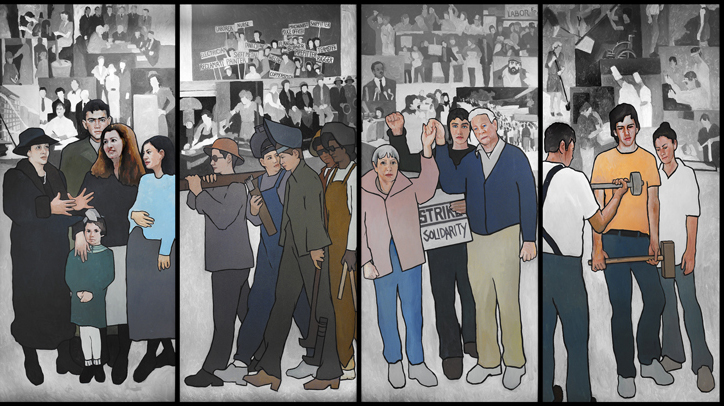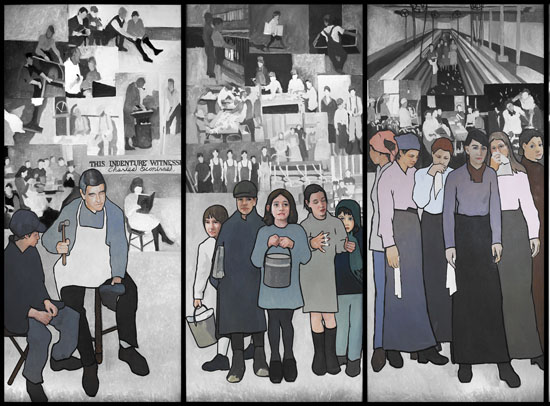
The former Main Labor Department mural, Judy Taylor, via The Portland Press Herald
As of Monday, a 36-foot mural in the Maine Department of Labor was removed by order of Governor LePage because of its perceived "anti-business" bias. The mural, created by artist Judy Taylor, depicted scenes from Maine's labor history and was criticized by local business leaders for being overtly "pro-union" and therefore inappropriate for a taxpayer-funded building. Debate over the mural, of course, appears to be an extension of the intense debates about the status of the labor movement nationwide, but particularly in states like Wisconsin and Illinois, where public-sector unions have experienced considerable political setbacks following the conservative "wave" election of 2010.
So where, you might ask, is the bias in this mural. Critics of LePage's decision point to the fact that this mural is simply an objective depiction of historical facts. Indeed, it would appear that the facts aren't really in question. Rather, proponent's of removal tend to simply say that there is just something about the mural that makes them uncomfortable. As the The Portland Press Herald reports, one anonymous letter writer claims that, "In studying the mural I also observed that this mural is nothing but
propaganda to further the agenda of the Union movement. I felt for a
moment that I was in communist North Korea where they use these murals
to brainwash the masses."
I'd like to briefly consider the mural debate and alongside other debates about the nature of liberal bias, particularly in the wake of the James O'Keefe NPR "sting" and the resignation of top NPR executives. NPR's weekly show "On the Media" has, for the past three weeks, been featuring a lively and soul-searching debate on the nature of bias in media and how one detects it. For me, one of the most enlightening revelations to come out of this series was the relationship between fact and affect in the perception of liberal bias. Sam Negus, a conservative listener who was asked to participate in the discussion, could find little fault with the factual reporting offered by NPR and agreed that, for the most part, NPR journalists attempted to mediate between both sides of contentious debates, though he noted a couple of cases in which he felt conservative positions were marginalized. One such case, he argued, was reporting on labor conflicts in Wisconsin and Indiana:
There were a couple of journalists and they started the show talking
about the labor situation, obviously, Wisconsin and Indiana. So the
panelists were talking, and one of the first observations that one of
the guests made was that the situation in Wisconsin would probably
galvanize the American labor movement. And the tone of her voice told me
very clearly that, that she was thrilled by that, which she has every
right to be.
What I didn't hear was another guest who shared my ideological
concerns with the overarching goals of labor unionism. There was nobody
there I felt speaking for the electorate of Wisconsin. The people of
Wisconsin went to the polls and they returned the Wisconsin Democrats as
the minority in the Senate. And what happens when you’re in the
minority is bills get passed that you don't like. That’s democracy, you
know.
So, in addition to the perceived one-sidedness of the discussion, Negus objects to the affect of the reporter, the "tone of her voice." This comes up a few times in the conversation between Negus, Ira Glass, and host Brooke Gladstone. At one point Negus says:
Maybe the best way to explain it would just be that there are
assumptions. It, it, it’s – you can explain facts, but the way that you
state facts or the way that you structure them, sometimes it’s more than
others and sometimes it’s because I'm, I'm sensitive.
I'm aware of my own biases, too. I understand sometimes I'm reading
into questions hostility that isn't there, but sometimes it’s definitely
there. And I'll give you a, an example that, that my wife and I have
kind of joked about a couple of times. We remember very clearly the
morning after the 2006 midterms when the Democrats took back the House.
It was just obvious that the anchors on Morning Edition and, and the
other shows that followed were happy. You, you can't hide when you’re
happy, right?
The ways in which people perceive bias (and I suspect that this applies to liberals perceiving conservative bias as well), seems to have as much to do with the affective or aesthetic qualities of the report or artifact in question as it does with the "facts" in question. So perhaps this does help explain why the mural, which, according to supporters, is a portrayal of objective historical events, was viewed to be offensive by some.

Seen from a certain perspective, the drab colors and the stark, two-dimensional quality of the painting could evoke a kind of Soviet austerity. I suspect that the dress of the women in the right panel above--with kerchiefs that have a "Russian" feel--could bring up the same could contribute that that vague (and vaguely sinister, for some) Communist aura. In other words, the detection of bias in this mural seems to be partially--if not primarilly--aesthetic and associative.


Recent comments
2 years 29 weeks ago
2 years 44 weeks ago
2 years 44 weeks ago
2 years 50 weeks ago
3 years 4 weeks ago
3 years 4 weeks ago
3 years 4 weeks ago
3 years 6 weeks ago
3 years 6 weeks ago
3 years 6 weeks ago